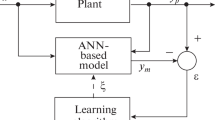Abstract
Safe operations of unmanned rotorcraft hinge on successfully accommodating failures during flight, either via control reconfiguration or by terminating flight early in a controlled manner. This paper focuses on autorotation, a common maneuver used to bring helicopters safely to the ground even in the case of loss of power to the main rotor. A novel nonlinear model predictive controller augmented with a recurrent neural network is presented that is capable of performing an autonomous autorotation. Main advantages of the proposed approach are on-line, real-time trajectory optimization and reduced hardware requirements.
Similar content being viewed by others
References
Abbeel, P., Coates, A., Hunter, T., Ng, A.Y.: Autonomous autorotation of an RC helicopter. In: Proc. 11th International Symposium on Experimental Robotics (2008)
Anand, S.: Domestic use of unmanned aircraft systems: evaluation of policy constraints and the role of industry consensus standards. Journal of Engineering and Public Policy 11 (2007)
Aponso, B., Bachelder, E., Lee, D.: Automated autorotation for unmanned rotorcraft recovery. Presented at AHS international specialists’ meeting on unmanned rotorcraft (2005)
Carlson, R.: Helicopter performance—transportation’s latest chromosome: the 31st annual Alexander A. Nikolsky lecture. J. Am. Helicopter Soc. 47(1) (2002)
Clothier, R., Walker, R.: Determination and evaluation of UAV safety objectives. In: Proc. 21st International Unmanned Air Vehicle Systems Conference, pp. 18.1–18.16 (2006)
Clothier, R., Walker, R., Fulton, N., Campbell, D.: A casualty risk analysis for unmanned aerial system (UAS) operations over inhabited areas. In: Proc. 12th Australian International Aerospace Congress and 2nd Australasian Unmanned Air Vehicles Conference (2007)
Dalamagkidis, K., Valavanis, K., Piegl, L.: On Integrating Unmanned Aircraft Systems into the National Airspace System: Issues, Challenges, Operational Restrictions, Certification, and Recommendations, Intelligent Systems, Control and Automation: Science and Engineering, vol. 36. Springer, New York (2009)
Dooley, L.W., Yeary, R.D.: Flight test evaluation of the high inertia rotor system. Final report for period 21 September 1976–February 1979 USARTL-TR-79-9, Bell Helicopter Textron (1979)
Haddon, D.R., Whittaker, C.J.: UK-CAA policy for light UAV systems. UK Civil Aviation Authority (2004)
Hayhurst, K.J., Maddalon, J.M., Miner, P.S., Dewalt, M.P., Mccormick, G.F.: Unmanned aircraft hazards and their implications for regulation. In: Proc. 25th IEEE/AIAA Digital Avionics Systems Conference, pp. 1–12 (2006)
Hazawa, K., Shin, J., Fujiwara, D., Igarashi, K., Fernando, D., Nonami, K.: Autonomous autorotation landing of small unmanned helicopter. Transactions of the Japan Society of Mechanical Engineers C 70(698), 2862–2869 (2004)
Johnson, W.: Helicopter optimal descent and landing after power loss. NASA TM 73244, Ames Research Center, National Aeronautics and Space Administration (1977)
Lee, A.Y.N.: Optimal landing of a helicopter in autorotation. Ph.D. thesis, Department of Aeronautics and Astronautics, Stanford University (1985)
Lee, A.Y.N.: Optimal autorotational descent of a helicopter with control and state inequality constraints. J. Guid. Control Dyn. 13(5), 922–924 (1990)
Leishman, J.G.: Principles of Helicopter Aerodynamics, 2nd edn. Cambridge Aerospace Series. Cambridge University Press, Cambridge (2006)
Weibel, R.E.: Safety considerations for operation of different classes of unmanned aerial vehicles in the national airspace system. Master’s thesis, Massachusetts Institute of Technology (2005)
Xia, Y., Wang, J.: A recurrent neural network for nonlinear convex optimization subject to nonlinear inequality constraints. IEEE Trans. Circuits Syst. I 51(7), 1385–1394 (2004). doi:10.1109/TCSI.2004.830694
Xia, Y., Wang, J.: A recurrent neural network for solving nonlinear convex programs subject to linear constraints. IEEE Trans. Neural Netw. 16(2), 379–386 (2005). doi:10.1109/TNN.2004.841779
Xia, Y., Leung, H., Wang, J.: A projection neural network and its application to constrained optimization problems. IEEE Trans. Circuits Syst. I 49(4), 447–458 (2002). doi:10.1109/81.995659
Xia, Y., Feng, G., Kamel, M.: Development and analysis of a neural dynamical approach to nonlinear programming problems. IEEE Trans. Automat. Contr. 52(11), 2154–2159 (2007). doi:10.1109/TAC.2007.908342
Author information
Authors and Affiliations
Corresponding author
Rights and permissions
About this article
Cite this article
Dalamagkidis, K., Valavanis, K.P. & Piegl, L.A. Autonomous Autorotation of Unmanned Rotorcraft using Nonlinear Model Predictive Control. J Intell Robot Syst 57, 351–369 (2010). https://doi.org/10.1007/s10846-009-9366-2
Received:
Accepted:
Published:
Issue Date:
DOI: https://doi.org/10.1007/s10846-009-9366-2




